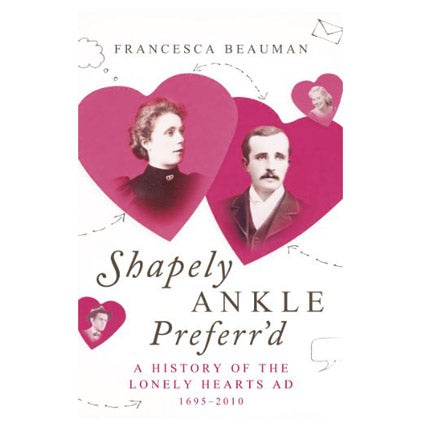Shapely Ankle Preferr'd: A History of the Lonely Hearts, By Francesca Beauman
An affecting account with a GSOH

You can't hurry love / No you just have to wait," lamented Diana Ross and the Supremes, echoing the ancients' wisdom for surrendering to the mysteries of the heart.
No such surrender for the determined ancients of England who, ever since the first variation on the Would Like To Meet (WLTM) plea appeared in The Times in 1695, attempted to chivvy the process along with a discreetly-placed advertisement.
The sociologist Anthony Giddens has suggested that advertising for love arose from the "commodification of the self in later modernity". Yet the lonely-hearts column is not a recent invention, as we discover in Francesca Beauman's intriguing "secret history", which mines material across three centuries. The first such advert appeared under the heading "Matrimonial", and employed the language that was to dominate this practice for at least a century: that of men bargaining for women of fortune. "The advertiser is a young Bachelor of 30, of genteel person and address... would be happy to meet with a young Lady or Widow... who is inclined to enter into that happy state, and can command at least £500..."
For a time, the line between fact and fiction became blurred, with many adverts thought to be invented for the entertainment of readers. "A worthy plump, fresh, free and willing Widdow", apparently seeking pleasures of the flesh, and a "gentleman of very considerable fortune... afflicted with an incurable weakness in his knees, occasioned by the kick of an Ostrich in the East Indies", were most probably among them.
The way in which "matrimonials" evolved offers a fascinating social history of Britain, from the influx of economic migrants to London in the 1690s (making the prospect of marriage more complex) to Victorian Britain's rising culture of commerce and advertising and the drop in the male population after the First World War. By 1921, Britain had a surplus of 1.7 million women. One frank advert read: "Lady, fiance killed, will gladly marry officer totally blinded or otherwise incapacitated in the War".
The "matrimonial" met its death with the birth of the Pill, when marriage and sex were irrevocably disentangled, and the modern "Lonely Heart" was born. This thorough and thoroughly amusing book suggests that what lonely hearts have always needed is a thick skin, a willing heart and, above all, a GSOH.
Join our commenting forum
Join thought-provoking conversations, follow other Independent readers and see their replies
Comments